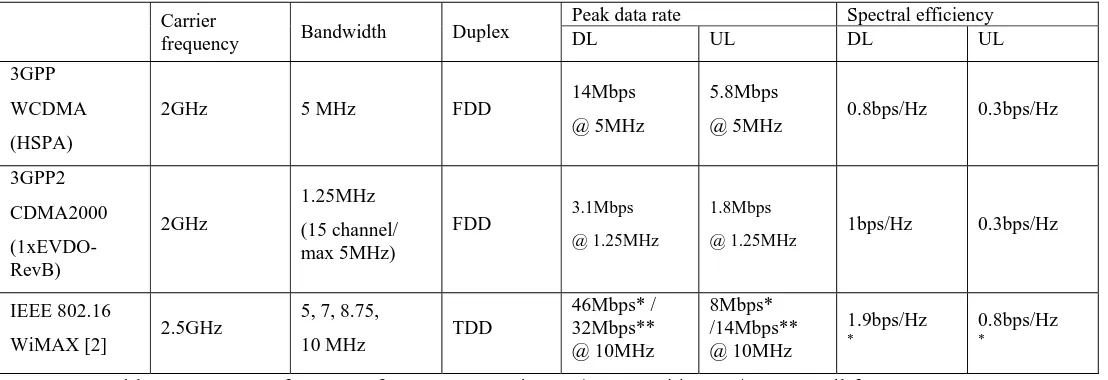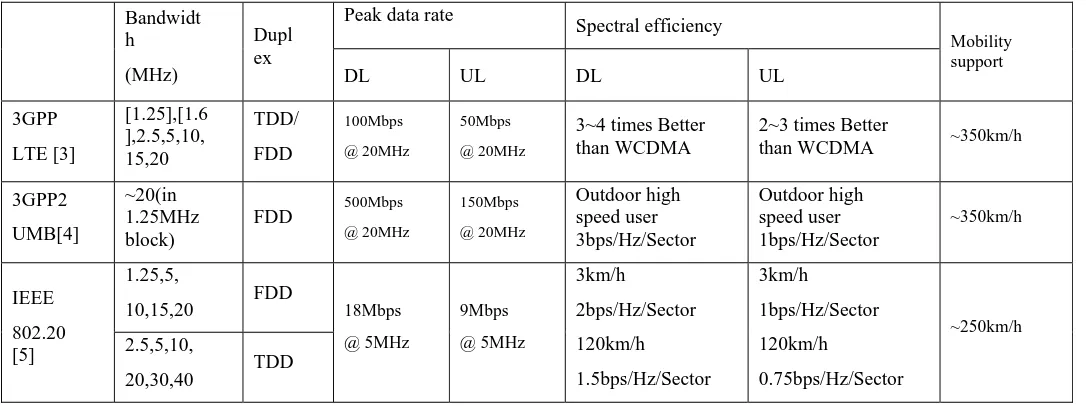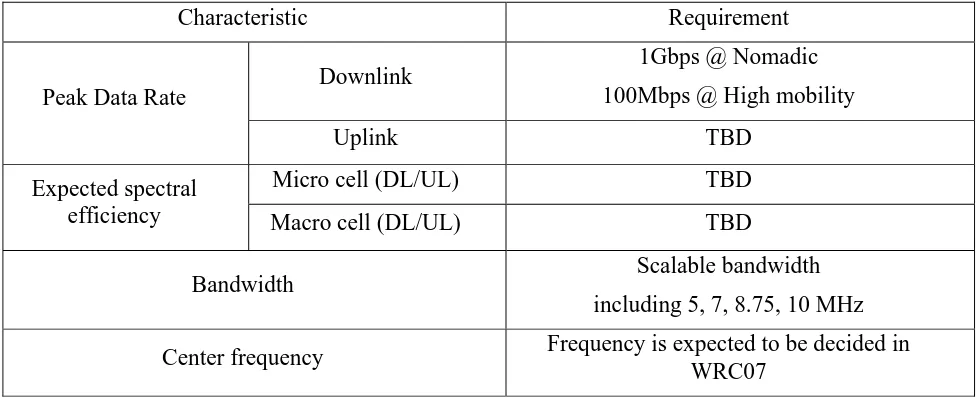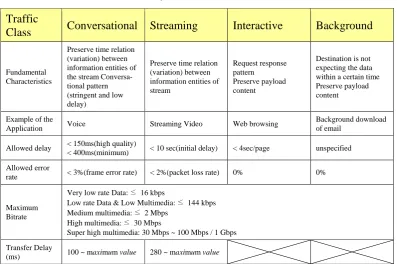0
Project IEEE 802.16 Broadband Wireless Access Working Group <http://ieee802.org/16> Title IEEE 802.16m Requirements
Date Submitted
2007-01-12
Source(s) Wookbong Lee, Binchul Ihm,
Ronny (Yong-Ho) Kim, LG Electronic Inc.
LG R&D Complex, 533 Hogye-1dong, Dongan-gu, Anyang, 431-749, Korea
Voice: +82-31-450-1879 Fax: +82-31-450-7912
[mailto:ronnykim@lge.com]
Re: Call for Initial Input
Abstract This contribution introduces requirements to 802.16m for discussion. Purpose This document introduces a 802.16m requirements
Notice This document has been prepared to assist IEEE 802.16. It is offered as a basis for discussion and is not binding on the contributing individual(s) or organization(s). The material in this document is subject to
change in form and content after further study. The contributor(s) reserve(s) the right to add, amend or withdraw material contained herein.
Release The contributor grants a free, irrevocable license to the IEEE to incorporate material contained in this contribution, and any modifications thereof, in the creation of an IEEE Standards publication; to copyright
in the IEEE’s name any IEEE Standards publication even though it may include portions of this
contribution; and at the IEEE’s sole discretion to permit others to reproduce in whole or in part the resulting IEEE Standards publication. The contributor also acknowledges and accepts that this contribution may be made public by IEEE 802.16.
Patent Policy and Procedures
The contributor is familiar with the IEEE 802.16 Patent Policy and Procedures
1
Requirements for 802.16m
Wookbong Lee, Binchul Ihm, Ronny (Yong-Ho) Kim LG Electronics, Inc.
1. Introduction
IEEE 802.16m amends the IEEE 802.16 WirelessMAN-OFDMA specification to provide an advanced air interface for operation in licensed bands. It will meet the cellular layer requirements of IMT-Advanced next generation mobile networks [1]. It will be designed to provide significantly improved performance compared to other high rate broadband cellular network systems. For the next generation mobile networks, it is important to consider increasing peak, sustained data rates,
corresponding spectral efficiencies, system capacity and cell coverage as well as decreasing latency and providing Quality-of-Service while carefully considering overall system complexity.
1.1 System performance of systems in legacy spectrum
The following table shows system performance of current system or candidate for IMT-2000.
Peak data rate Spectral efficiency Carrier
frequency Bandwidth Duplex DL UL DL UL
3GPP
WCDMA
(HSPA)
2GHz 5 MHz FDD 14Mbps
@ 5MHz
5.8Mbps
@ 5MHz 0.8bps/Hz 0.3bps/Hz
3GPP2
CDMA2000
(1xEVDO-RevB)
2GHz
1.25MHz
(15 channel/ max 5MHz)
FDD 3.1Mbps
@ 1.25MHz
1.8Mbps
@ 1.25MHz 1bps/Hz 0.3bps/Hz
IEEE 802.16
WiMAX [2] 2.5GHz
5, 7, 8.75,
10 MHz TDD
46Mbps* / 32Mbps** @ 10MHz
8Mbps* /14Mbps** @ 10MHz
1.9bps/Hz
*
0.8bps/Hz
*
2
Table 2 shows system requirements for ongoing projects for beyond IMT-2000 broadband wireless communication systems.
Peak data rate
Spectral efficiency
3~4 times Better than WCDMA
2~3 times Better
than WCDMA ~350km/h
3GPP2
Table 2. system requirement for beyond IMT-2000
2. 802.16m
requirements
Since IEEE 802.16m shall meet the cellular layer requirements of IMT-Advanced next generation mobile networks, it is important to understand what kinds of features and technologies are required for the IMT-Advanced.
2.1 Key features of IMT-Advanced
As identified in various documents including ITU-R M.1645, IMT-Advanced can be as following: - High degree of commonality of design worldwide
- Compatibility of services within IMT-Advanced and with the fixed networks - High quality
- Small terminal suitable for worldwide use - Worldwide roaming capability
- Capability for multimedia applications within a wide range of services and terminals
3
2.2 Key technologies of IMT-Advanced
Key technologies of IMT-Advanced can be listed as below [6]: 1. System related technologies
- Voice over IP (VoIP) - Optimization of IP,
- Fault-tolerant network architecture - Mobile platform technology - Security and privacy
- Cryptography
- Authentication and mobile electronic commerce - Billing
- Intelligent data filtering
2. Access network and radio interface - Modulation and coding schemes - Multiple access schemes
- Adaptive radio interface
- New antenna concepts and technologies
- Handover between different radio interfaces (vertical and horizontal) - Dynamic QoS control
3. Utilization of spectrum
- Multiple Input Multiple Output (MIMO) - Adaptive antennas
- Adaptive dynamic channel assignment - Spectrum sharing
2.3 802.16m Requirements
2.3.1 General Requirements
- IEEE 802.16m architecture shall be flexible to support required services from ITU-R. - IEEE 802.16m system shall support different cell sizes which are expected for cellular layer
systems.
- IEEE 802.16m system shall provide seamless interworking with legacy radio access systems including legacy 802.16 systems.
4
- Required QoS for IMT-Advanced shall be provided including end-to-end latency, throughput, and error performance.
- IEEE 802.16m system shall provide powerful and efficient security mechanism to protect network, system, and user.
2.3.2 System Requirements 2.3.2.1 Air Interface Requirement
IEEE 802.16m specification shall meet the following performance requirement.
Characteristic Requirement
Downlink 1Gbps @ Nomadic
100Mbps @ High mobility Peak Data Rate
Uplink TBD
Micro cell (DL/UL) TBD
Expected spectral
efficiency Macro cell (DL/UL) TBD
Bandwidth Scalable bandwidth
including 5, 7, 8.75, 10 MHz Center frequency Frequency is expected to be decided in
WRC07 Table 3. Proposed air interface requirement for IEEE 802.16m
2.3.2.2 QoS requirements
IMT-Advanced system shall support the MAC level QoS to meet the end user QoS requirements for the various applications. The system should support the following types of services with different data rates, delay, and packet error rates.
- Conversational/Real-time Services - Streaming Services
- Interactive Services - Background Services
The system should realize low-delay and highly reliable radio transmission using error control techniques, and enable flexible allocation of radio resources depending on the required QoS.
Minimizing the system latency under various conditions (e.g. handover, re-entry from Idle Mode, and packet transmission) should be required.
5
Table 4. QoS Classes and Profiles
Traffic
Class Conversational Streaming Interactive Background
Fundamental Characteristics
Preserve time relation (variation) between information entities of the stream Conversa-tional pattern (stringent and low delay)
Preserve time relation (variation) between information entities of stream
Request response pattern Preserve payload content
Destination is not expecting the data within a certain time Preserve payload content
Example of the
Application Voice Streaming Video Web browsing
Background download of email
Allowed delay < 150ms(high quality)
< 400ms(minimum) < 10 sec(initial delay) < 4sec/page unspecified
Allowed error
Super high multimedia: 30 Mbps ~ 100 Mbps / 1 Gbps
Transfer Delay
(ms) 100 ~ maximum value 280 ~ maximum value
The characteristics and examples of the above mentioned QoS classes are as described below.
- The Conversational class means the traffic communicated in real time, which is sensitive in delay or jitter. This traffic class includes Voice over IP.
- The Streaming class means the traffic occurring when the user receives the video and audio service in real time. This traffic class is sensitive to delay or jitter.
- The Interactive class means the traffic occurring when the user requests and receives data to/from the server. This traffic class includes web browsing.
- The Background class shows the typical best effort characteristics. No transmission delay is considered when transmitting data in this class. It has very low data packet transmission error rate. This traffic class includes email, SMS and file downloading.
The following parameters are used to classify QoS.
- Maximum bit rate (kbps): The number of bits transmitted from/to the IMT-Advanced system for certain period of time.
- Allowed delay: The delay that meets QoS of the service
- Allowed error rate: The error rate that meets QoS of the service 2.3.2.3Security requirements
Requirements for Secrecy and Privacy
- More powerful, enhanced (high-speed/small-size and low-power) confidentiality and integrity protection for traffic transmission, control information
6
- Reliable and flexible service availability protection scheme Requirements for Inter-working Security
- Delay constrained handover and roaming support without changing the security level (Especially, seamless mobility across heterogeneous networks with the negotiation of security
mechanisms/algorithms)
- Minimum performance/capacity degradation due to the security feature provisioning
Reference
[1] P802.16m PAR
[2] WiMAX Forum, 2006, “Mobile WiMAX – Part I: A Technical Overview and Performance Evaluation.” [3] 3GPP TR25.913 V7.3.0, 2006 March, “Requirements for Evolved UTRA (E-UTRA) and Evolved UTRAN (E-UTRAN).”
[4] 3GPP2 S.R0113-0, 2006 May, “cdma2000 Enhanced Packet Data Air Interface System - System Requirements Document.”
[5] IEEE 802.20 PD-06r1, 2004 July, “System Requirements for IEEE 802.20 Mobile Broadband Wireless Access Systems – Version 14.”
[6] Rec. ITU-R M.1645, 2003, “Framework and overall objectives of the future development of IMT-2000 and systems beyond IMT-2000.”



